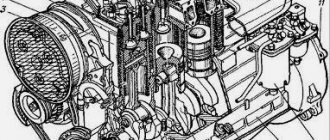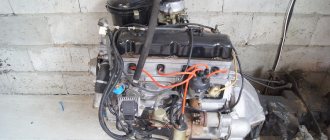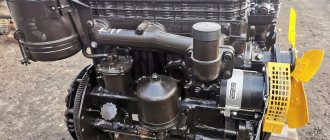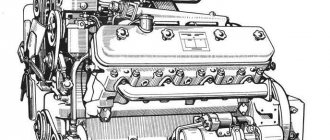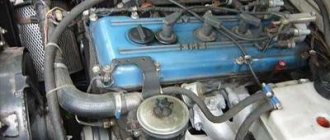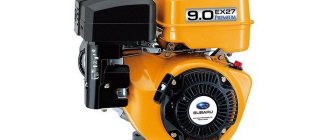Specifications
The Gas 52 engine has fairly high technical characteristics. The cars were equipped with a 6-cylinder in-line engine, which significantly distinguished them from other engine models . So, let's look at the main technical characteristics and design of the power units:
| Name | Characteristic |
| Model | GAZ-52 |
| Type | Straight six |
| Fuel | Petrol |
| Injection | Carburetor |
| Volume | 3.5 liters (3485 cm3) |
| Power | 75 horses |
| Number of cylinders | 6 |
| Number of valves | 12 |
| Cylinder diameter | 82 mm |
| Cooling | Liquid |
| Cylinder block material | Cast iron |
| Block head material | Aluminum |
| Cylinder operating order | 1-5-3-6-2-4 |
Modernization and technical improvements of GAZ 52 engines
The most common breakdown in this internal combustion engine has always been considered premature wear of the connecting rod liners when operating the vehicle at high speeds. This was his so-called Achilles heel. This drawback brought drivers a lot of trouble and a lot of trouble.
The thing is that these parts had only one hole for the passage of lubricating fluid, which was not enough for these units. A successful solution was the advice of experienced mechanics. They suggested using liners borrowed from the ZIL-130. These parts fit perfectly in size instead of the old samples. The material used to manufacture the ZIL 130 liners is an alloy of steel and aluminum. This material is so hard that it is impossible to drill an additional hole for the passage of motor oil at home. An excellent solution was to cut special grooves in the upper soft layer of metal. As a result of the appearance of grooves 2 millimeters wide and deep, the passage of lubricant has improved significantly.
Tip: To prevent oil from leaking through the hole in the connecting rod, it is recommended to plug it using improvised means. For example, a small piece of foil will do.
After turning the channels, a significant decrease in oil pressure in the lubrication system was noted, which did not allow the vehicle to be operated at high crankshaft speeds (less than 70 km/h). What helped? The GAZ 52 engine became completely indestructible after work was carried out to reduce the gaps between the gears in the oil pump, as a result of which the pressure in the lubrication system significantly increases.
Major renovation
Do-it-yourself overhaul of the GAZ 52 engine is quite typical, as for other 6-row engines. As practice shows, most car enthusiasts do this on their own, since the cost of restoration is quite expensive.
At the beginning of the repair, the motor is disassembled, which is typical for the restoration operation. The piston group is disassembled, the crankshaft is pulled out, and the cylinder head is removed. The next stage is to carry out diagnostic work.
Diagnostics
During the diagnostic process, ICE Gas 52 undergoes measurements. So, the piston group, as well as the crankshaft, are measured. Accordingly, the motor is inspected for cracks. According to measurements, the GAZ 52 engine, which is being repaired, is being selected for pistons. The main repair dimensions are pistons - 82.5mm, 83mm. In the future, there is no point in boring, and the block is lined.
As for the crankshaft, it is bored on a special machine for turning crankshafts. Thus, typical repair sizes that are installed on journals are 0.25 mm, 0.50 mm and 0.75 mm. In very rare cases, a size marked 1.00 mm is used. This dimension of the crankshaft journals significantly reduces hardness, which can most likely lead to the engine heart breaking and other consequences.
Boring
Boring of GAZ 52 (engine) must be carried out by professionals and very accurately. Thus, the power unit is installed on a special stand on which the cylinders are sharpened. If the block was lined before, it is still necessary to sharpen the liners and adjust the pistons to the gaps.
Also, to avoid imbalance, the piston group is adjusted according to weight. So, pistons and connecting rods (or rather bushings) are adjusted by weight using the grooving method.
The next step is honing. Each cylinder is honed to a mirror finish. This is necessary so that combustion occurs correctly, and the pistons with oil scraper rings slide and completely remove oil from the walls.
After these operations are carried out, the motor is placed on a surface grinding machine and the surface is ground. So, from 1 to 5 millimeters are removed until the surface becomes smooth. The next step will be washing to clean the entire internal world of the engine from chips and dust.
Assembly
The assembly process is quite long. First, the piston group is tied up, or rather the crankshaft is laid, and connecting rods with pistons are attached to it. Next, the upper part of the cylinder block is rebuilt. Thus, guide bushings, valves, and valve seats are changed (if the block is very loose at the valve mounting points). If necessary, pressure testing is carried out and cracks are eliminated. This is done using argon welding.
Next, the motor begins to assemble. During the assembly process, the water pump is diagnosed. If necessary, the shaft assembly, bearing and impeller are replaced. The pump is one of the last elements to be installed. Subsequently, a pallet is placed. When everything is assembled, oil is poured into the engine. For a GAZ 52 engine, this is 10 liters of lubricant - M-8.
The last stage is rightfully running in and adjusting the valves. So, this power unit first runs cold, and then runs hot. After a run of 1000 km, it is worth carrying out maintenance by changing the oil, oil filter and adjusting the valve mechanism.
GAZ-52 cylinder block
The cylinders of the GAZ-52 engine are located in one block vertically in a row and are cast from gray cast iron integral with the upper part of the crankcase. To reduce wear, liners made of acid-resistant cast iron 50 mm long are pressed into the upper part of the cylinders. The wall thickness of the sleeve is 2 mm. There is a water jacket along the cylinder block 51-002011. To improve the filling of the cylinders with the combustible mixture and clean them from combustion products, the intake and exhaust channels are made in the block separately for each cylinder. The exhaust valve seats are made of special high-hardness heat-resistant cast iron and pressed into the block; The intake valve seats are made directly in the body of the block.
Block 51-002011 has drilled oil channels, the unused ends of which are closed with screw plugs. In the upper part of the crankcase of the GAZ-52 cylinder block there are four main bearings of the crankshaft, the axis of which, in order to reduce the pressure of the pistons on the cylinder walls, is shifted relative to the cylinder axis towards the camshaft by 3 mm. The main bearing caps are precisely secured by grooves cut into the top of the crankcase. Each cover is attached to the block with two bolts, the heads of which are cottered. The crankcase main bearing caps undergo final processing at the factory together with the block, and therefore must be installed in their places during assembly. To eliminate the possibility of mixing up the middle covers during installation, at the factory they are branded with a serial number or letters that are stamped on the end of the cover and on the lower plane of the cylinder block (near the cover lock). The cover nuts are tightened at the factory with a torque wrench. The torque when tightening them should be 12.5–13.6 kgm. In the upper part of the crankcase there are also four camshaft journal supports, into which bushings made of steel-babbite tape are pressed. The clutch housing is attached to the rear plane of the GAZ-52 cylinder block with six bolts, fixed to the block with two locating pins.
The necessary alignment of the crankshaft and the input shaft of the gearbox is ensured by the final machining of the clutch housing assembly with the cylinder block. Therefore, it is impossible to move clutch housings from one block to another. GAZ-52 cylinder head The head is common to all cylinders. The cylinder head is removable, cast from aluminum alloy.
Between the block and the cylinder head there is a sealing gasket made of printed steel-asbestos sheet. The compressed thickness of the gasket is approximately 1.5 mm. The windows of the combustion chambers and water holes are edged with 0.22 mm thick sheet metal. To prevent asbestos from sticking to the block and the head, the gasket must be rubbed on both sides with graphite powder before installation. Rice. 3. Sequence of tightening the nuts of the GAZ-52 cylinder head. The cylinder head is attached to the block with 33 studs (their thread diameter is 11 mm), under the nuts of which flat cyanidated washers are placed. The order of tightening the GAZ-52 block head, as well as tightening these nuts, is very important; The nuts should be tightened in two steps: first preliminary, and then finally, in the sequence shown in Fig. 3. It is necessary to tighten or tighten the nuts on a cold engine. A tightening made on a hot engine will not be sufficient after it cools down due to the different linear expansion coefficients of the aluminum head and steel studs. To ensure proper tightening of the nuts, it is recommended to use a torque wrench. The tightening torque should be 6.7-7.2 kgcm. If such a wrench is not available, tighten the nuts with a regular spanner wrench from the driver's tool kit. To avoid breaking the studs or deforming the cylinders, tighten the nuts without jerking, using one hand.
________________________________________________________________________________
Spare parts for Lviv loaders 4014, 40814, 40810, 4081, 41030 are shipped to all cities of Russia: Kemerovo, Ekaterinburg, Chelyabinsk, Novosibirsk, Ulan-Ude, Kirov, Perm, Krasnoyarsk, Irkutsk, Omsk, Barnaul, Tomsk, Bratsk, Tyumen , Lysva, Novokuznetsk, Miass, Serov, Chita, Berezovsky, Mezhdurechensk, Nizhny Tagil, Biysk, Minusinsk, Satka, Kurgan, Novy Urengoy, Norilsk, Noyabrsk, Oktyabrsky, Orenburg, Orsk, Prokopyevsk, Prokhladny, Pskov, Rubtsovsk, Rybinsk, Ryazan , Salavat, Saransk, Sarapul, Severodvinsk, Sibay, Sochi, Stavropol, Stary Oskol, Sterlitamak, Surgut, Syzran, Taganrog, Tambov, Tobolsk, Ust-Ilimsk, Ukhta, Khabarovsk, Khanty-Mansiysk, Chistopol, Chusovoy, Shadrinsk, Shakhty, Shelekhov, Elektrostal, Elista, Engels, Yakutsk, Vologda, Nizhny Novgorod, St. Petersburg, Belgorod, Orel, Kazan, Rostov-on-Don, Voronezh, Bryansk, Krasnodar, Saratov, Murmansk, Tula, Noginsk, Volgograd, Ivanovo, Penza , Cheboksary, Volzhsky, Yaroslavl, Syktyvkar, Izhevsk, Samara, Makhachkala, Volzhsk, Yoshkar-Ola, Sokol, Ufa, Arkhangelsk, Tver, Podolsk, Ulyanovsk, Smolensk, Togliatti, Vladikavkaz, Petrozavodsk, Kursk, Vladimir, Cherepovets, Naberezhnye Chelny and etc.
Features of mounting the GAZ 52 engine
The power unit is installed on the vehicle frame. Fastening is carried out at 4 points at the locations of special support pads made of rubber with vulcanized metal reinforcing inserts. The feet of the engine housing are securely fixed to the supports.
When attaching the engine housing, use:
- special bolts;
- brackets;
- spacers;
- metal rods;
- nuts;
- washers;
- rubber gaskets of the same thickness, etc.
Gaps between the legs of the engine housing and the supports are eliminated by securely tightening the threaded connections.
Why is it interesting to boost the GAZ 52 engine?
After such simple upgrades, the main problems of the GAZ 52 engine completely disappeared. Now he is not afraid of daily operation at maximum crankshaft speeds under any conditions:
- Heat, frost, sudden changes in ambient temperature.
- Road surfaces of varying quality (from smooth asphalt of highways to broken country roads).
- Driving on flat surfaces, as well as on roads with sharp descents and ascents.
Important: The information posted in the previous section contains data based on the recommendations of experienced car owners who have boosted the GAZ 52 engine.
The main advantages of GAZ 52 engines:
- simplicity of design;
- relatively low cost;
- reliability;
- long service life (more than 200,000 km);
- absence of complex devices such as chains, rods, tensioners, dampers, balancers, rollers, etc.

